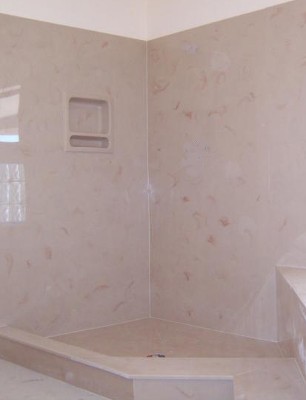Cultured Marble Shower
by J
QUESTION:
I have just learned that my badly stained shower floor is Romastone man-made marble. Will stain remover made for marble clean this up? Any other tips?
ANSWER:
J, Thanks for you question....
Without seeing the stain, it's hard to comment definitively, but I'm afraid the short answer probably is.... No. You do have some slim hope and a couple options, though.
As you stated, Romastone is a man-made product often called "agglomerated" or "cultured" marble.
Cultured marble is versatile with many designs and colors available, sinks and soap trays can be seamlessly incorporated into the design, but it is basically... plastic.
Cultured marble is made by mixing crushed marble with a polyester resin. It is then poured into molds, sanded smooth and in most cases that I'm aware of... a gel coating is applied to the surface which makes it water-proof and stain resistant, but not damage-proof.
The color of a cultured marble shower or countertop can fade with time or sunlight and the surface coating can be damaged or removed by chemicals.
The "stain" is most likely the result of years of use... a constant assault of feet, water, soap, shampoo, shaving cream and cleaning products that have worn away any protective coating causing the cultured marble to absorb everything and become discolored or stained.
The solution: As noted, you are probably out of
Honestly though, I have limited experience working with cultured marble, so...
My best suggestion would be to try and locate a professional experienced in resurfacing cultured marble. You may have a shot by sanding down the surface until the stains are gone and then re-applying a protective coating.
Of course, also contact Romastone. They should be able to tell you more precisely what your options are and possibly help you locate a local professional.
One other option you have is to paint it with specially formulated epoxy that is engineered for application to showers, tubs and countertops. Again, this is a professional job, but there are companies readily available that perform this work.
Probably not as cheap as painting, but replacing the floor will likely be less expensive than any potential restoration project.
Sorry I couldn't provide a more optimistic answer. If you do find a solution that works, please report back using the comments form below. It would be very helpful to all of us!
Comments for Cultured Marble Shower
|
||
|
||
|
||




